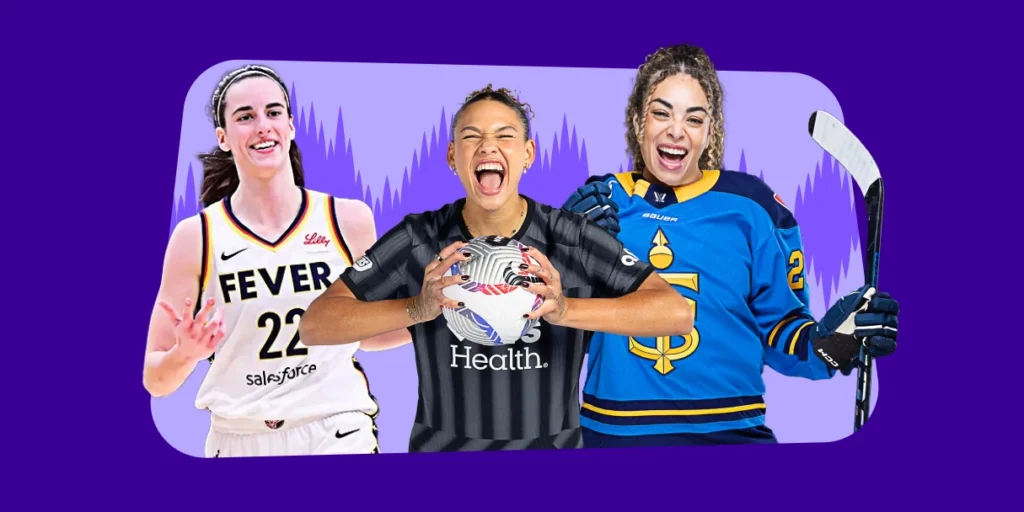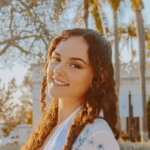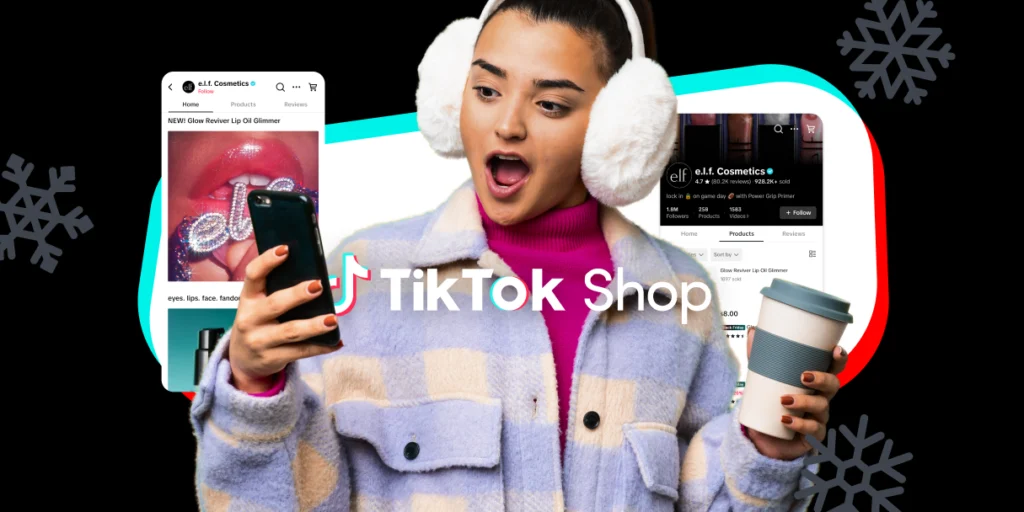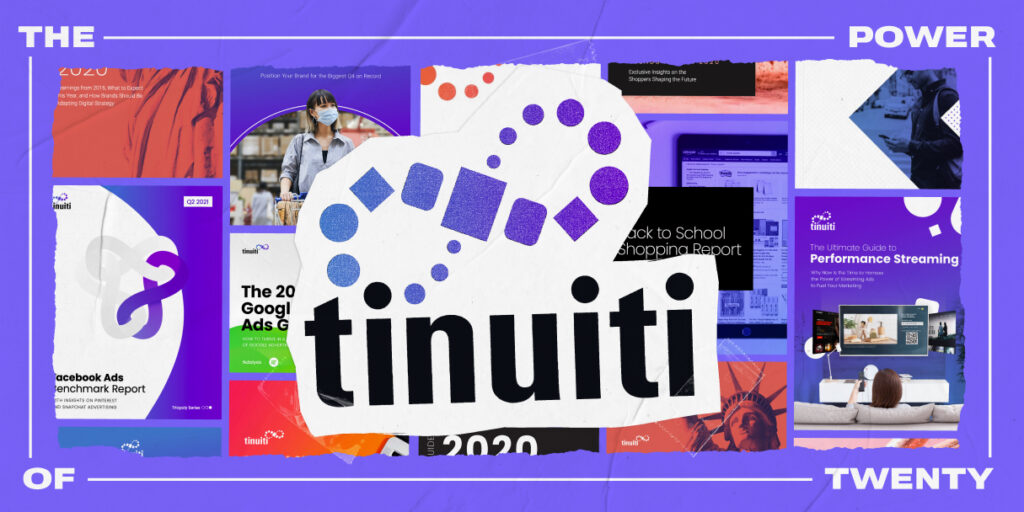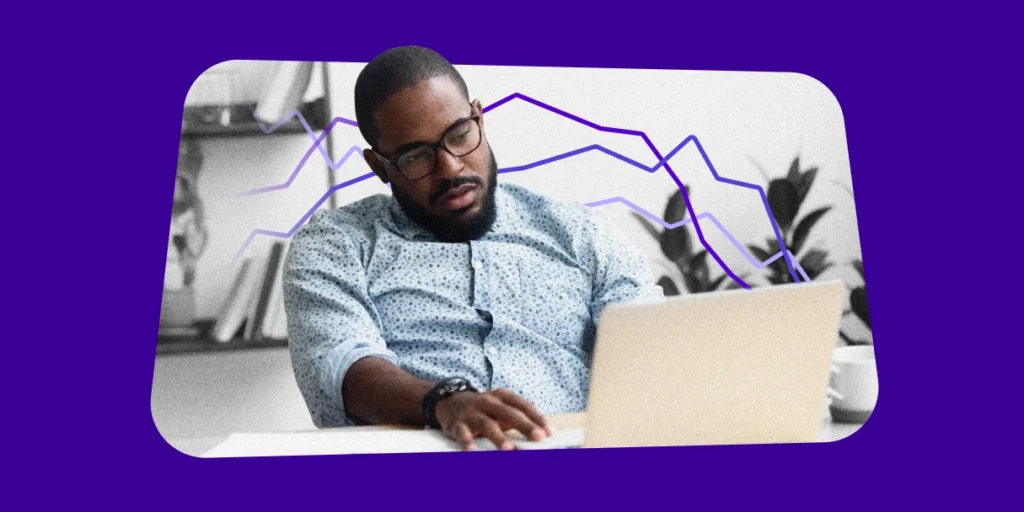With over 2 billion active users, robust audience targeting capabilities, and some of the most advanced ad units offered anywhere — Facebook advertising can be one of the most effective marketing channels for any brand.
The problem is that not everyone knows how to advertise on Facebook; many marketers burn through their ad spend without a clear understanding of how to use Facebook ads to achieve their goals.
In this guide we’ll go over the most effective Facebook ad types for retail brands, the Facebook targeting and advertising funnel, how to get started, and tips and strategies from our Paid Social experts.
“Facebook is a full-funnel marketing opportunity for retail brands. Many still struggle, however, to understand how to allocate budget, apply resources, and implement a full-funnel strategy that takes advantage of the opportunities available with Facebook advertising.”
-Sarah Sanchez, Manager of Performance Social at CPC Strategy
How To Make A Facebook Ad Campaign: Step-by-step Walkthrough
You can start advertising on Facebook by heading to your Facebook Business Page and then opening Facebook Business Manager from the top right drop-down menu to locate Facebook Ads Manager.
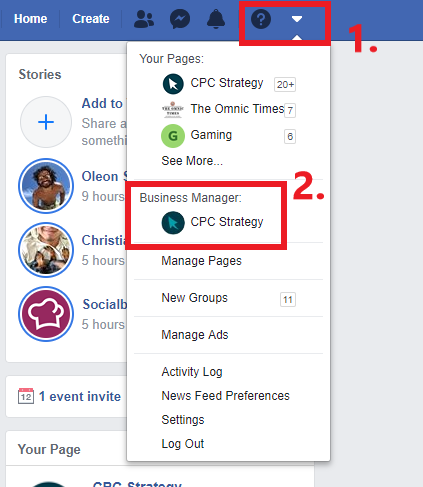
Once you’re inside the Facebook Business Manager dashboard, you’ll select Facebook Ads Manager to start your first campaign.
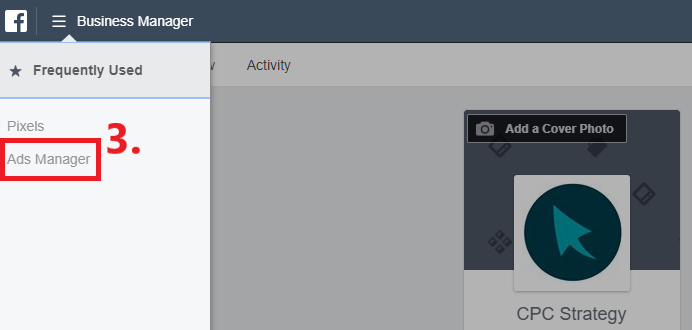
Once inside Facebook Ads Manager, navigate to the Campaigns tab and select the green Create button.

You’re now ready to create your first Facebook advertising campaign.
You will navigate prompts that will ask you for your campaign objectives, audience targeting, placements, and finally the ad sets you want to include in your campaign.
If you want more information on which campaign types and objectives to choose based on your marketing goals, you can check out Facebook’s Beginner Guide To Ad Objectives.
How Much Does It Cost To Advertise On Facebook?
You can begin advertising on Facebook with a budget as small as $5.
Every advertiser’s cost will differ depending on their campaign budgets and the ads required to meet their marketing objectives.
Facebook’s CPCs and CPMs have steadily increased over the years, but the good news is that advertisers can lower their costs of advertising on Facebook by honing in their targeting, controlling their budgets, and implementing other best practices outlined in this guide.
Here are 2018 average costs-per-metric based on research provided by AdStage:
- CPM (cost per thousand impressions) average $11.20
- CPC (cost per click) average $0.48
- CTR (click through rate) average 2.36%
Best Facebook Ad Types For Retailers
Let’s face it: there are a ton of different ad types offered by Facebook nowadays.
It can be quite confusing when first starting out, so here’s a quick overview of which ad types fit best depending on your marketing goals.
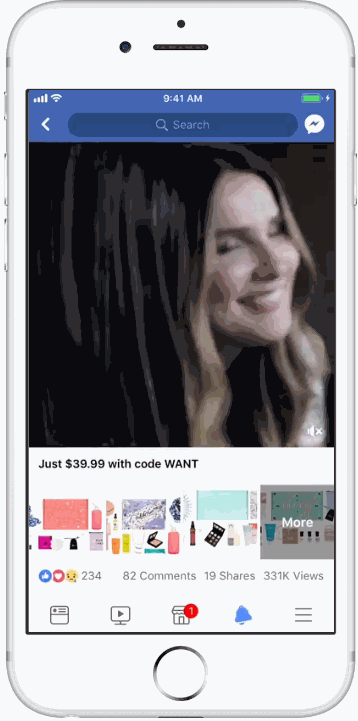
Facebook Instant Experience Ads (Formerly Canvas Ads)
Great For: Driving Conversions, Traffic, Branding
Facebook Instant Experience ads are a new and improved version of Facebook’s Canvas ads, which offer an immersive, full-screen mobile experience for a business to showcase its products and tell its brand story in a visually compelling way.
Instant Experiences are:
- Optimized for mobile devices
- Load almost instantly
- Offer a media-rich experience to capture the attention of your target audience
“With easy to use templates, and load times that are 15 times faster than traditional retail sites, Instant Experiences should help brands better connect and engage potential customers on Facebook and Instagram.”
-Brent Villiott, Social Marketing Manager at CPC Strategy
Facebook Image Card Ads
Great For: Branding, Driving Traffic
Facebook image ads are one of the simplest yet effective ways to showcase your brand and drive traffic to your store on or off of Facebook.
This ad unit allows you to showcase your brand and product offering with a single image that includes a customizable call to action button.
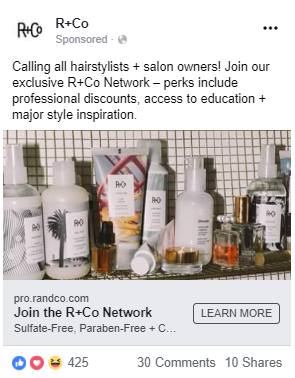
R+Co has produced excellent results by enticing their target audience with a value prop: join their exclusive hair stylist network for discounts, tutorials, and inspiration.
“One of the reasons this ad has been successful is there is a very clear call to action & value prop. The creative is organic and feels native to your feed, which helps boost engagement. The copy and creative is fun and represents R+Co’s brand voice well.”
-Savannah Montgomery, Social Marketing Manager at CPC Strategy
Facebook Video Ads
Great For: Driving Video Views, Branding, Retargeting
Facebook video ads are becoming more and more effective in today’s mobile world.
Facebook’s video placements are particularly powerful because they can be used for retargeting initiatives that help you hone in on customized audiences that you can later target with other advertising strategies down the line.
Blink has gained lots of attention for its simple yet genius video ads: showing what goes on in and around your home while you’re away.
“Videos like this do very well for CTR and engagement. It’s a silly concept, but it stops you in the feed and makes you laugh. Blink is a tech brand, but they don’t take themselves too seriously in their marketing which I think people appreciate!”
-Casey Edwards, Senior Social Marketing Strategist at CPC Strategy
Facebook Carousel Ads
Great For: Branding, Driving Traffic
Interactive and visually appealing, Carousel Ads are perfect if you have multiple products you want to promote or an array of services you need to build awareness of.
They’re also mobile friendly, and they can be placed right within the Facebook Newsfeed, making their click-through-rates better than most.
This allowed viewers to interact and browse an entire line of products, sign up for their newsletter, and eventually visit their store.
Tip: Use Carousel Dynamic Product Ads (DPAs) to retarget your most qualified audiences using the Pixel. An interactive carousel of products gives the audience more choices — and more reasons to return to your store.
Facebook Lead Ads
Great For: Lead Generation
Facebook Lead Ads are designed to make the mobile sign-up process easier by automatically populating contact information that people have provided to Facebook including email addresses.
Lead Ads allow Facebook users to sign up for things like newsletters, price estimates, follow-up calls and business information, which can be extremely valuable to retailers looking to expand and improve their customer interaction.
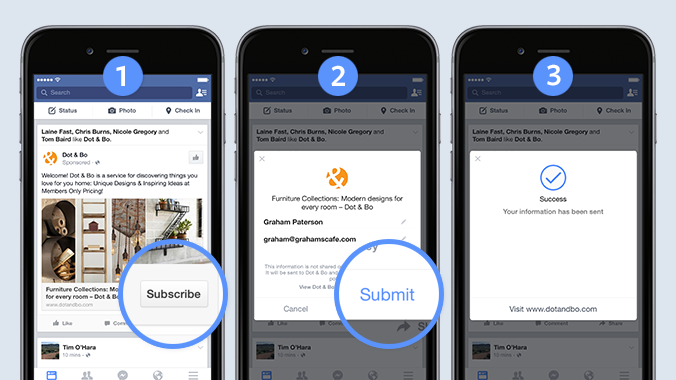
“Facebook lead ads are great for gathering email sign-ups, information, and finding value in various conversion types.”
-Casey Edwards, Senior Social Marketing Strategist at CPC Strategy
Pro-tip: Use Offline Conversion Tracking to measure how lead ads impact customers as they move down the conversion path by tracking phone calls, in-person visits and in-store transactions.
Facebook Dynamic Ads
Great For: Driving Conversions, Retargeting
Facebook Dynamic Ads are feed-based ads that serve up a retailer’s offerings on Facebook users’ feeds, and can be targeted to specific audiences based on
actions they’ve taken on the website (for instance, viewed a product page or added items to a cart).
Based on your own website data, Dynamic Ads offer a form of remarketing that enable you to reach users based on past actions they completed on your website or within your store.
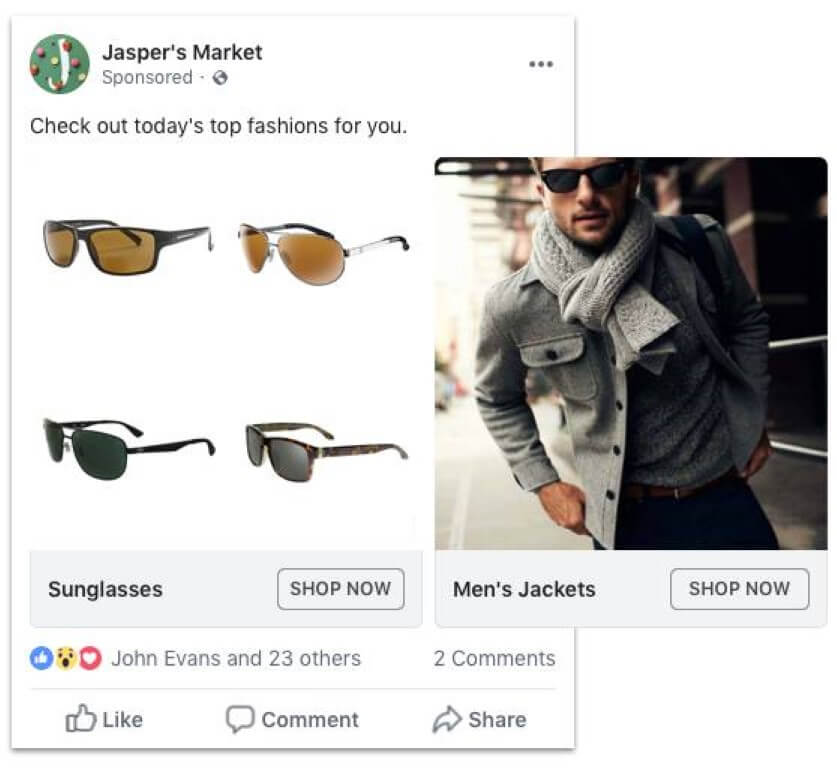
You can target users based on the content they viewed on your site, items they added to their shopping cart, products they purchased and more.
“Facebook users don’t want to leave Facebook to shop — they’re there for social interaction. With Dynamic Product ads, we are able to bring the shopping experience to Facebook users without them needing to leave their Facebook feed.”
-Gavin Magoon, Retail Search Manager, CPC Strategy
Pro-tip: Try upsell & cross-sell tactics for turning one-time customers into repeat buyers, and you should see a higher return on your Facebook ads investment through Q4 and beyond.
Facebook Audience Targeting & Advertising Funnel
With over 2 billion active users, Facebook has more audience data than any other advertising platform — making Facebook the perfect tool for advertisers to hone in on their target audience.
It’s important segment your audience targeting to reflect the Facebook’s advertising funnel, which starts broadly at the top based on interests and demographics and narrows down to high-interest shoppers like website custom audiences (WCA) that you can retarget with Dynamic Product Ads.
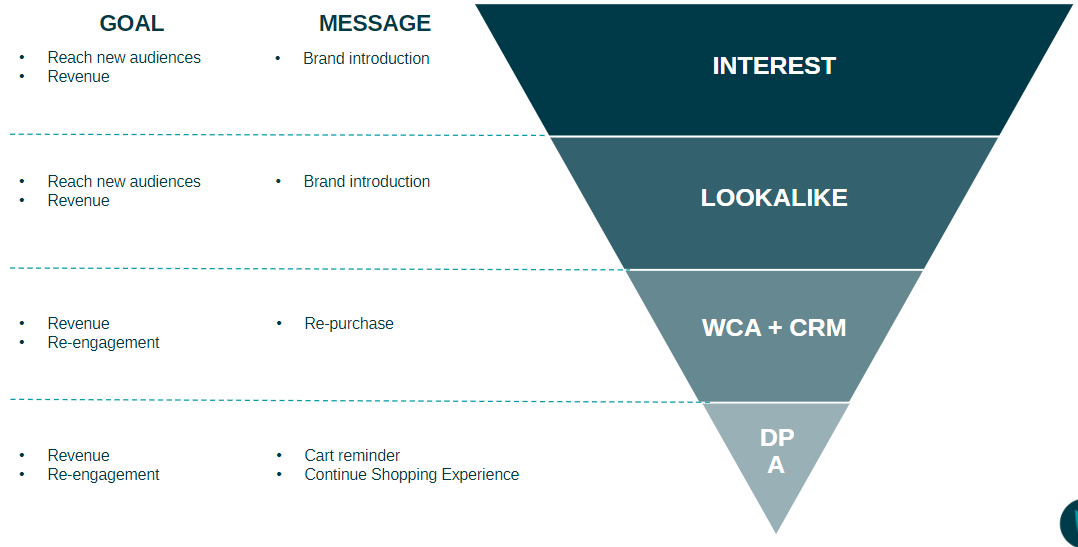
Interest/Behavior: Audiences populated from their page likes, conversations, and behaviors on Facebook.
Lookalike: Audiences created from first party audiences (WCA, CRM, Engagement, Video Viewers) that Facebook determines
have similar behaviors to the first party audiences.
WCA: Website Custom Audiences. Audiences based off the Facebook pixel placed on the website.
CRM: Email-based audiences. Audiences populated from the brand’s email list and matched with Facebook users.
Let’s take a look at two of Facebook’s most powerful audience targeting capabilities: Facebook Custom audiences and Lookalike audiences.
Facebook Custom Audiences
Facebook Custom audiences are audiences based off of your website visitors, email lists, CRM data, and more.
You can upload a list of email addresses, phone numbers, or website visitors and Facebook will deliver a targeted ad to that audience.
These robust targeting capabilities make Custom audiences a powerful tool for retargeting and even prospecting for users similar to your best-performing audiences using Facebook Lookalike audiences.
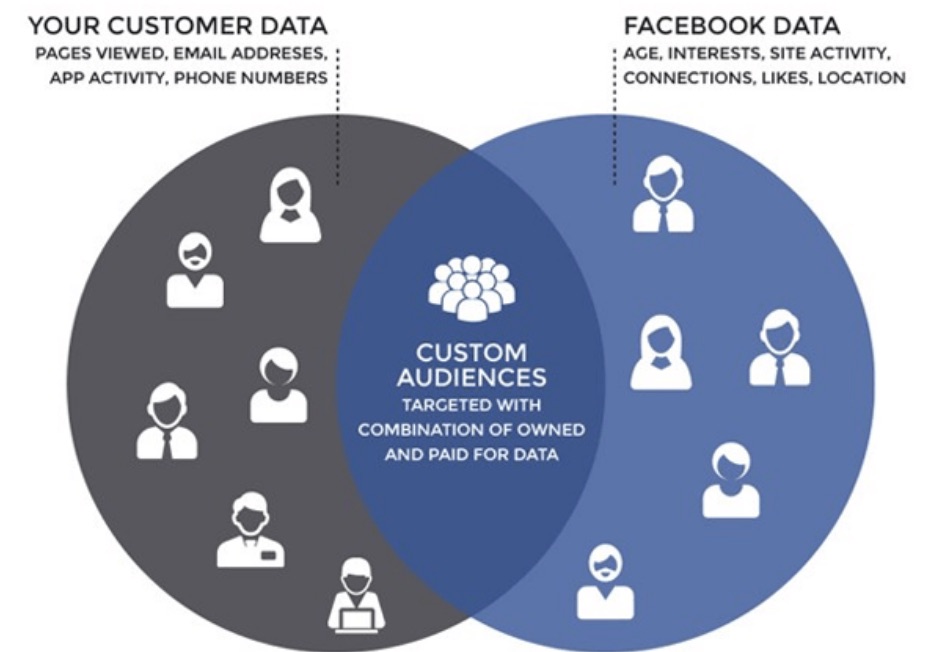
During Black Friday through Cyber Monday 2017 our Facebook data revealed that:
- First party audiences performed significantly better than any other audience type (aka more than double the average return). They also
had the highest click-through-rate. - Email audiences had the highest CPCs.
- Lookalike audiences had the highest average order value (25%
higher) compared to the remaining audiences.
Facebook Lookalike Audiences
Facebook Lookalike audiences allow advertisers to target consumers who mirror or look similar to former or already existing customers they have.
After providing several datasets, Facebook’s machine learning look for patterns and characteristics in your current users, leads, or customers – such as age, gender, or interests – and determine what similarities they possess when compared to other users that have not interacted with your business in the past.
Facebook Lookalike audiences have become incredibly renowned amongst Facebook advertisers as it allows them to reach an entirely new group of prospective customers they may not have found otherwise.
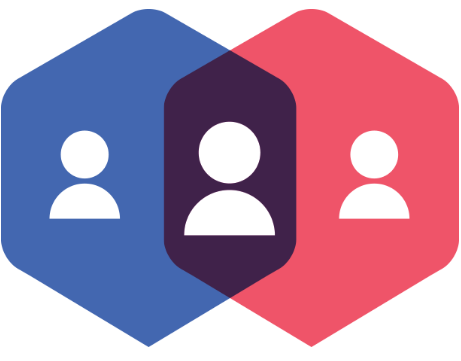
In order to have a Lookalike audience made, businesses will need to have at least one source from the following:
- Mobile Apps (with App Events)
- Facebook Page
- Custom Audience
- Conversion Pixel
Strategies you should consider when targeting:
1. Expand placements on all of desktop/mobile newsfeed, desktop right-rail, and Instagram.
2. Create interest-based audiences and leverage all available data into market age, gender, demographics (ex. household income), behavior, competitor page interest, and in-market cohorts.
3. Create lookalike audiences based on both CRM audience and website custom audience data.
The Facebook Pixel: Tracking & Retargeting Users
The Facebook Pixel is Javascript code in the header of a website that allows website owners to monitor the actions shoppers take after clicking on their ads.
Advertisers can use that data to retarget those visitors and deliver targeted ad messaging on Facebook.
The Facebook Pixel is your key to getting the most out of your online marketing; it allows you to track user actions once they click through your ad and head to your website, app or landing page.
You can get answers to these questions:
- Did they buy a product?
- Fill out a form?
- Add something to their cart?
- Look through your catalog?
Pro-tip: Ensure the Facebook pixel is installed and custom events are properly tracking off-Facebook and offline conversions.
6 Facebook Advertising Tips From The Experts
1. Refine Your Targeting To Improve ROI And Reduce Wasted Ad Spend
Getting in front of the right audience is as vital, so you’ll want to continue to refine your Facebook audience targeting.
“Prune and create those custom audiences. There are two axes you should care about–the frequency and the recency of a previous purchase,” says Nii Ahene, COO and Co-founder of CPC Strategy.
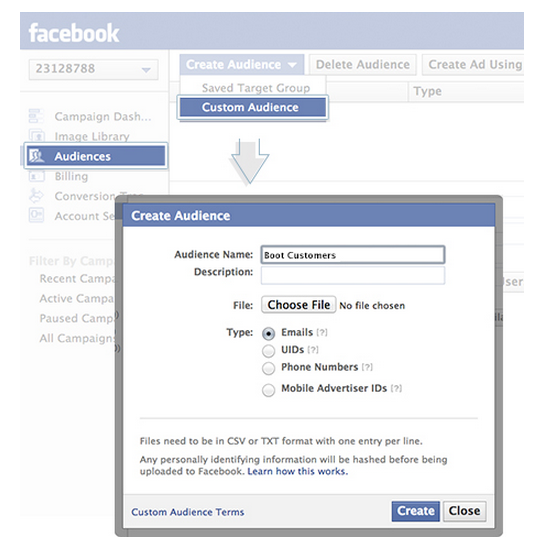
“Segmenting your audience list as much as possible is really important when uploading any CRM or other data,” says Sarah Sanchez, a Manager of Performance Social at CPC Strategy.
“For example, for Lookalike audiences, you should aim for a match rate between 70-80%. Instead of uploading information in one shot, I’d recommend segmenting as much as possible to develop a more refined list.”
“Look at people who have made repeat purchases. Looking at non-purchasers, people whose information you have – such as an email address – that haven’t actually purchased from you. Segmenting in all of these different ways will make your customer lists much more effective.”
2. Optimize Your Ads For Mobile & Video
According to last year’s data, nearly 1 in 3 mobile shoppers believe that video is the best way for them to discover new products.
That number is likely only to increase as Facebook and Instagram continue to deliver major improvements to their video offering on both platforms, such as Shopping for Stories, video for Dynamic Ads, Carousel Video Ads, Instant Experience Ads and more.
- Make sure your website is optimized for mobile traffic and conversions.
- Break out your ad set placements so you can optimize your spend on mobile.
- Ensure your creative and copy is optimized towards mobile viewing (i.e., shortened copy, readable overlays, shortened headlines).
- Leverage organic and paid video content to capture attention.
- Keep your video ads shorter rather than longer for improved mobile performance.
3. Implement A/B & Split Testing For Your Facebook Ads
A/B testing your Facebook ads can dramatically affect your ad performance. And doing it before the holidays means you’ll avoid the headache of guessing whether something’s wrong with your ad copy or your audience when ads fail in mid-December.
This will also teach you a lot about your target audience & what type of messaging resonates best with them.
For example, lifetime value customers (LTV) might respond well to a carousel ad, but your new customers might convert better using Dynamic Ads or video link ads.

Facebook Split Testing gives advertisers on the platform the ability to implement different versions of their ads to see what works best and how to optimize campaigns for better results moving forward.
4. Ensure Your Tracking Pixel Is In Good Health
The Facebook Pixel is your key to getting the most out of your online marketing — and critical to tracking conversions and your customer journeys for Q4.
It’s what allows you to track user actions once they click through your ad and head to your website, app or landing page — data that you can then use for lower funnel retargeting campaigns with powerful Dynamic Product Ads that keep your product offering in front of an engaged user.
You’ll want to make sure that you have your Facebook Pixel activated on all necessary touchpoints: your website, application, landing page, and anywhere else that allows for HTML code.
5. Audit Your Competitors’ Facebook Ads
Facebook added a new “Info & Ads” section that enables anyone to view all of the active ads on a Facebook page—meaning you can now see what your competitors are doing.
All you have to do is click “Info and Ads”* on any other brand’s page. From there, you’ll be able to see:
- All ads actively running on Facebook’s advertising platform
- The date the page was created
- Historical changes to Page name
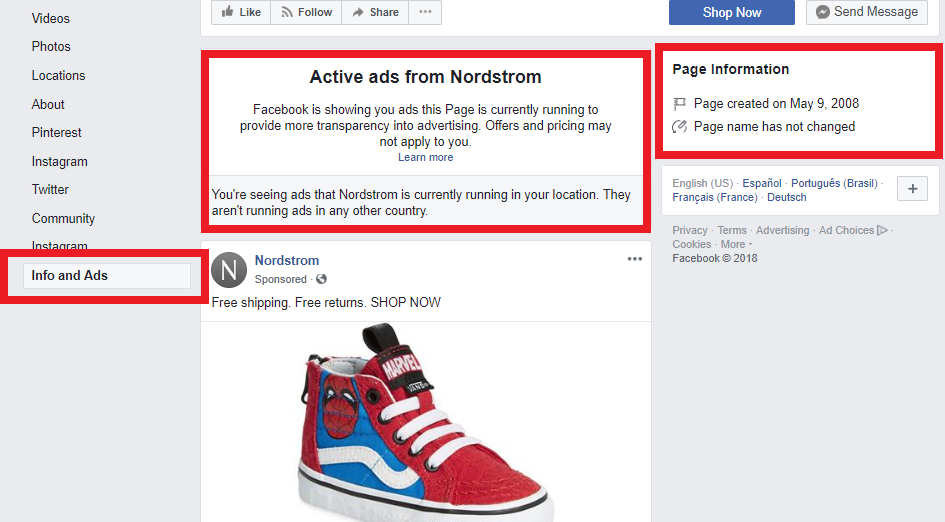
With this feature, you can learn from competitors and brands who have mastered the art of Facebook ads.
Use it to audit your own creative in relation to competitors to find any areas of creative opportunity you may not be taking advantage of.
6. Improve Your Ad Creative And Copy
A vital component of your Facebook marketing strategy is choosing the right creative and messaging for your audience.
From product photos to video, retail brands should test and analyze their creative and copy – leveraging tangible metrics to support and help them decide where and how to invest in creative efforts for their Facebook ads.
“Great ads are both engaging and showcase the product’s use. Boring creative and great creative can make the difference between thousands of CPCs and higher CTR. Your ad should compel people to stop in their feed, engage, and finally go to the website and purchase.”
-Brent Villiot, Social Marketing Manager at CPC Strategy
You Might Be Interested In






